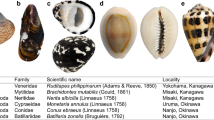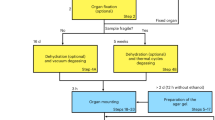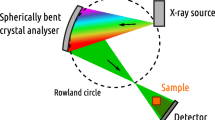Abstract
Propagation phase-contrast synchrotron radiation microtomography (PPC-SRμCT) has proved to be very successful for examining fossils. Because fossils range widely in taphonomic preservation, size, shape and density, X-ray computed tomography protocols are constantly being developed and refined. Here we present a 1-h procedure that combines a filtered high-energy polychromatic beam with long-distance PPC-SRμCT (sample to detector: 4–16 m) and an attenuation protocol normalizing the absorption profile (tested on 13-cm-thick and 5.242 g cm−3 locally dense samples but applicable to 20-cm-thick samples). This approach provides high-quality imaging results, which show marked improvement relative to results from images obtained without the attenuation protocol in apparent transmission, contrast and signal-to-noise ratio. The attenuation protocol involves immersing samples in a tube filled with aluminum or glass balls in association with a U-shaped aluminum profiler. This technique therefore provides access to a larger dynamic range of the detector used for tomographic reconstruction. This protocol homogenizes beam-hardening artifacts, thereby rendering it effective for use with conventional μCT scanners.
This is a preview of subscription content, access via your institution
Access options
Subscribe to this journal
Receive 12 print issues and online access
$259.00 per year
only $21.58 per issue
Buy this article
- Purchase on Springer Link
- Instant access to full article PDF
Prices may be subject to local taxes which are calculated during checkout







Similar content being viewed by others
References
Tafforeau, P. et al. Applications of X-ray synchrotron microtomography for non-destructive 3D studies of paleontological specimens. Appl. Phys. A Mater. Sci. Process. 83, 195–202 (2006).
Sutton, M.D. Tomographic techniques for the study of exceptionally preserved fossils. Proc. R. Soc. B 275, 1587–1593 (2008).
Donoghue, P.C.J. et al. Synchrotron X-ray tomographic microscopy of fossil embryos. Nature 442, 680–683 (2006).
Chaimanee, Y. et al. A Middle Miocene hominoid from Thailand and orangutan origins. Nature 422, 61–65 (2003).
Feist, M., Liu, J. & Tafforeau, P. New insights into Paleozoic charophyte morphology and phylogeny. Am. J. Bot. 92, 1152–1160 (2005).
Lak, M. et al. Phase contrast X-ray synchrotron imaging: opening access to fossil inclusions in opaque amber. Microsc. Microanal. 14, 251–259 (2008).
Pradel, A. et al. Skull and brain of a 300 million-year-old chimaeroid fish revealed by synchrotron holotomography. Proc. Natl. Acad. Sci. USA 106, 5224–5228 (2009).
Fernandez, V. et al. Phase-contrast synchrotron microtomography: improving noninvasive investigations of fossil embryos in ovo. Microsc. Microanal. 18, 179–185 (2012).
Sanchez, S., Ahlberg, P.E., Trinajstic, K., Mirone, A. & Tafforeau, P. Three dimensional synchrotron virtual paleohistology: a new insight into the world of fossil bone microstructures. Microsc. Microanal. 18, 1095–1105 (2012).
Carlson, K.J. et al. The Endocast of MH1, Australopithecus sediba. Science 333, 1402–1407 (2011).
Pierce, S.E. et al. Vertebral architecture in the earliest stem tetrapods. Nature 494, 226–230 (2013).
Nemoz, C. et al. Synchrotron radiation computed tomography station at the ESRF biomedical beamline. AIP Adv. 879, 1887–1890 (2007).
Weitkamp, T. et al. Parallel-beam imaging at the ESRF beamline ID19: current status and plans for the future. AIP Adv. 1234, 83–86 (2010).
Labiche, J.-C. et al. The fast-readout low-noise camera as a versatile X-ray detector for time resolved dispersive extended X-ray absorption fine structure and diffraction studies of dynamic problems in materials science, chemistry, and catalysis. Rev. Sci. Instrum. 78, 091301–091311 (2007).
Paganin, D., Mayo, S.C., Gureyev, T.E., Miller, P.R. & Wilkins, S.W. Simultaneous phase and amplitude extraction from a single defocused image of a homogeneous object. J. Microsc. 206, 33–40 (2002).
Acknowledgements
We acknowledge the ESRF for access to beamlines ID19 and ID17 (in-house beam time; proposals EC521, EC685), as well as R. Able (National History Museum, London), C. Martin (University of Manchester) and A. Heaver (University of Cambridge) for access to microtomography scanning equipment in their care. We thank J.-S. Steyer (Centre National de la Recherche Scientifique–Muséum National d'Histoire Naturelle, Paris) for providing fossil material for comparative tests. S.S. is supported by European Research Council grant 233111 (P.E. Ahlberg). V.F. is supported by a University Research Committee grant, University of the Witwatersrand. S.E.P. is supported by UK Natural Environment Research Council grants NEG0058771 and NEG00711X1 (J.A. Clack and J.R. Hutchinson).
Author information
Authors and Affiliations
Contributions
P.T. developed the concept, designed the protocol, conducted several experiments (including EC521) and contributed to the figures and writing of the manuscript. S.S. and P.T. conducted the experiments for EC685 (with assistance from S.E.P for specimen setup). S.S. wrote the manuscript and contributed to the figures. V.F. participated in initiating the protocol and performing a PPC-SRμCT comparative experiment, and contributed to the figures and writing of the manuscript. S.E.P. conducted the μCT comparative experiments and contributed to the figures and writing of the manuscript.
Corresponding author
Ethics declarations
Competing interests
The authors declare no competing financial interests.
Rights and permissions
About this article
Cite this article
Sanchez, S., Fernandez, V., Pierce, S. et al. Homogenization of sample absorption for the imaging of large and dense fossils with synchrotron microtomography. Nat Protoc 8, 1708–1717 (2013). https://doi.org/10.1038/nprot.2013.098
Published:
Issue Date:
DOI: https://doi.org/10.1038/nprot.2013.098
This article is cited by
-
Human fetal whole-body postmortem microfocus computed tomographic imaging
Nature Protocols (2021)
-
Imaging intact human organs with local resolution of cellular structures using hierarchical phase-contrast tomography
Nature Methods (2021)
-
Synchrotron phase-contrast microtomography of coprolites generates novel palaeobiological data
Scientific Reports (2017)
-
Hyperspecialization in Some South American Endemic Ungulates Revealed by Long Bone Microstructure
Journal of Mammalian Evolution (2016)
Comments
By submitting a comment you agree to abide by our Terms and Community Guidelines. If you find something abusive or that does not comply with our terms or guidelines please flag it as inappropriate.



